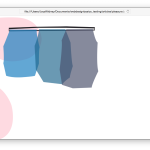I read Pleasurable design and agree with it entirely. As an industrial designer in our current global state of affairs it is extremely important to be away of what we are producing. If we produce a dangerous car we are murderers. We walk a very thin line as creates, with the constant possibility that we may do something wrong or that someone may be inspired by us to do something wrong. We play many roles as creator, we can be an entertainer, a stylist, a helping hand, a shelter and countless more. One of the most important facets of design to keep in mind is pleasure. There is never anything wrong in pure pleasure, it is never something we have to fear. I was inspired by Ronan and Erwan Bouroullec and decided to make a website inspired by their designs.
I set all the vectors i created off of their work to transparencies and percentages so that they would overlap in different ways when you expanded the page.

